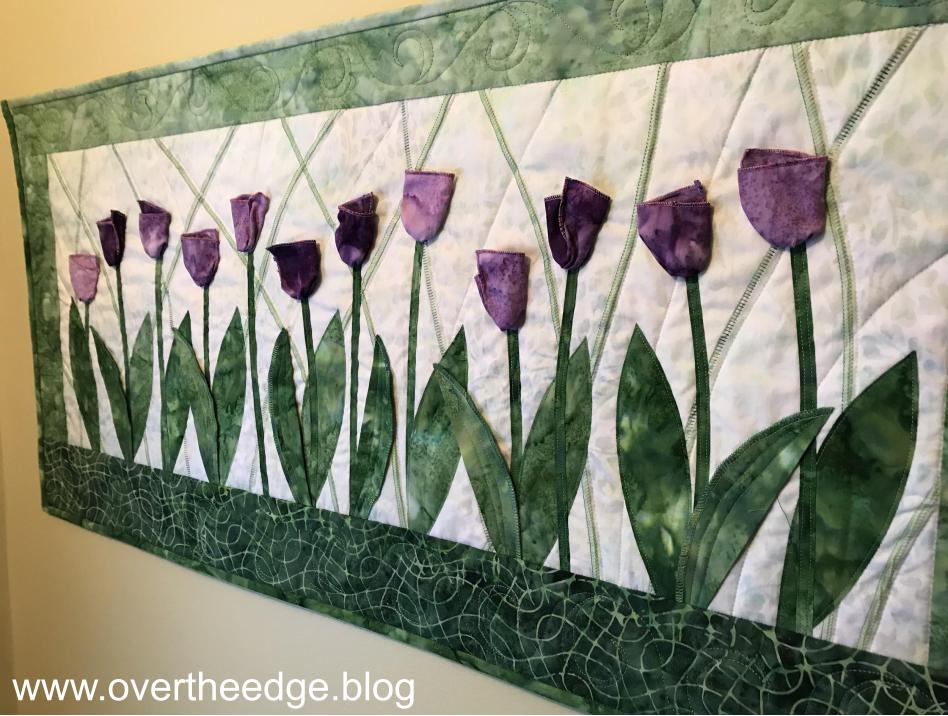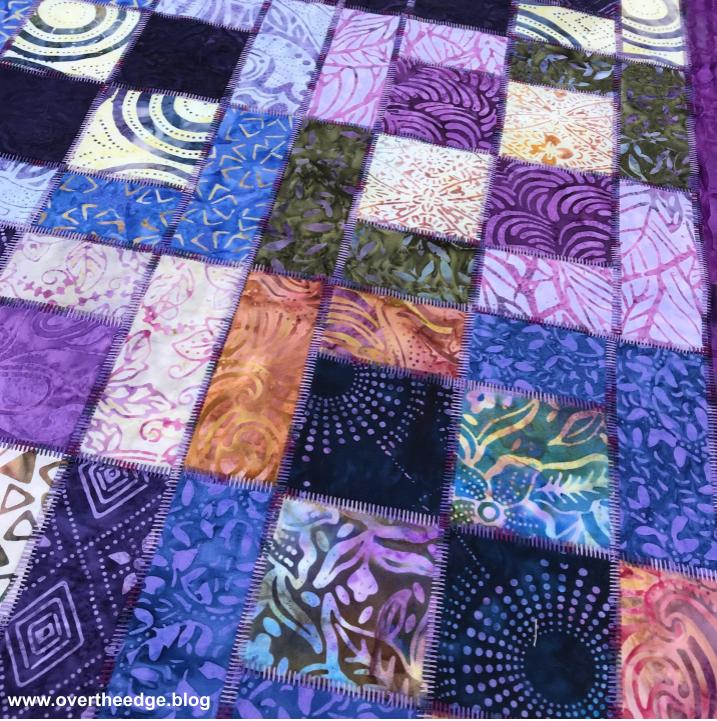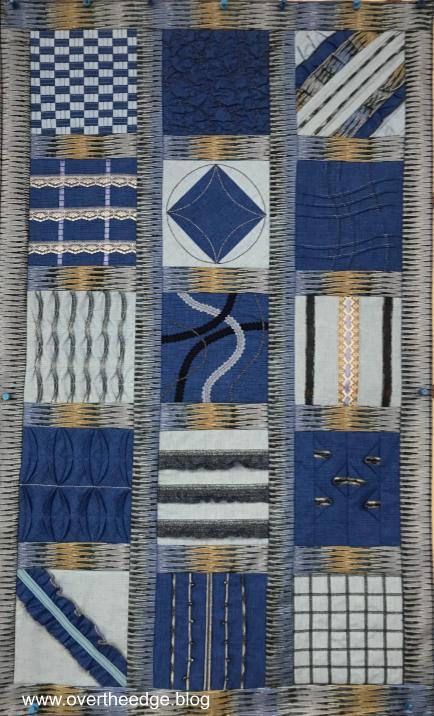Serge and Merge Quilts – Down the Pathway
Down the Pathway is a project from the book, Serge and Merge Quilts, by Sharon V. Rotz. As she says in her intro to the project “Have fun displaying your serging talents as you construct a tulip garden with dimensional flowers and leaves.” And I sure did! This quilt was fun to make!
I love my Down the Pathway quilt. It makes me happy! Every time I look at my quilt I think of a beautiful spring day. I serged it with a combination of flatlock, rolled hem and overlock stitches and merged it with traditional quilting on a sewing machine.
Fabric Prep
I chose an ombre purple batik fabric for my tulips and an ombre green batik for my stems, leaves and borders. The ombre fabrics gave me the perfect variety of colors for my tulips, greenery, borders and binding. The bottom border (or ground) was a coordinating green batik. I used a light green batik as the background (sky). The photo shows how I fussy cut my leaves, stems, borders and binding from the green ombre batik.
Create Background
The first step I took in creating the background of this quilt was to serge my “stems” using a flatlock stitch on the fold of the fabric. I serged some stems with the ladder side up and some with the loop side up. I used a variegated Madeira Polyneon thread for my flatlock stitches.
Flatlocking on the fold is a little different than flatlock piecing. By folding the fabric you can place the flatlock stitch in the center of the fabric rather than only on the edge. When you flatlock on the fold, you serge with the loops hanging half off of the fabric, which allows your fabric to lay flat when the stitch is pulled open. I recommend you practice flatlocking on the fold before you begin this part of your project. It takes a little more skill to get a nice even stitch than does flatlock piecing. Flatlock piecing is used to join two pieces of fabric and it is placed on the edge of the fabric. Sharon provides some information about flatlocking on page 16 of her book.
After finishing the flatlock “stems” I added the top and side borders. I did not miter my borders as is instructed in the book. Using a sewing machine, I quilted this piece to the batting/backing along each of the flatlock stems.
Create Tulips
I serged the edges of the tulips using a 3 thread rolled hem stitch with Madeira Polyneon embroidery thread in the upper looper. To create the three dimensional tulips, I gathered the bottoms by hand with a running stitch and a strong thread .
Layout, Fuse and Quilt Greenery and Attach Tulips
After laying out my stems and leaves in a pleasing arrangement, I fused them down with an iron and pressing sheet. The pressing sheet both protected my iron from the fusible web and my thread from the heat of the iron. After fusing, I stitched down the raw edges of the stems and leaves using a sewing machine. I left some leaves 3 dimensional, as it says in book. After finishing the leaves and stems, I hand stitched a tulip at the top of each stem.
Add Bottom Border
I added the bottom border after the tulips and greenery were attached to the batting and backing.
Machine Quilt Borders
I used a swirly leaf pattern for the free motion machine quilting of my borders, as you can see from the back side of my quilt in the photo below.
Add Binding and Finish
I used my rotary cutter and a ruler to trim and square my quilt sandwich before adding binding.
I chose to use two different parts of the green ombre batik fabric for my binding. The light colored green was the perfect choice for the top and right edge binding. And I used the darker green for left and bottom binding.
To finish the quilt, I added a hanging sleeve, which you can see pinned on the right side of the photo.
All done!
Down the Pathway Details
I included a few close up photos of the tulips, leaves and background flatlock stitching so you can better see the details.
Down the Pathway Class
I taught this as a class at my local fabric store. The class covered only the serger portion of the project (flatlocking, overlocking and rolled hem). Students did the rest on their own at home. A few of the students allowed me to share photos of their Down the Pathway quilts. Aren’t they beautiful. Spring is in the air!

A Few Final Words
It’s never too late to change something. After I finished the quilt, I stepped back to admire it from a distance. Everything looked great except one area of the background. My eyes kept being drawn to an area of the background that was a too dense with flatlock stems. I ended up removing one stem of flatlock stitches, and now I think it’s perfect! Can you spot the change?
Serge and Merge Quilts – Down the Pathway
The book, Serge & Merge Quilts was published back in 2009. After eleven years, it may be unavailable from your local store. If you can’t find a copy at the store, try the internet.
In case you would like to learn more about the author and Serge and Merge Quilts – Down the Pathway, here is a link to Sharon’s blog post. http://sharonrotz.blogspot.com/2013/04/tulips-springing-up.html
The Down the Pathway quilt is just one of several projects I have completed from Sharon’s book, which I will share with you in the future. I hope you enjoyed this post!






















